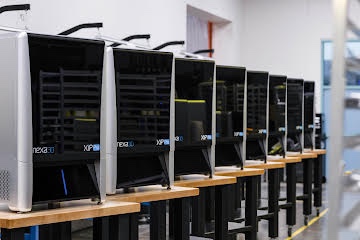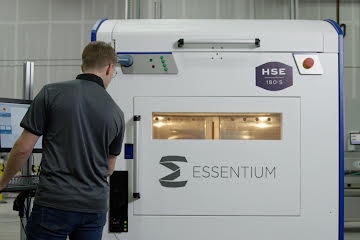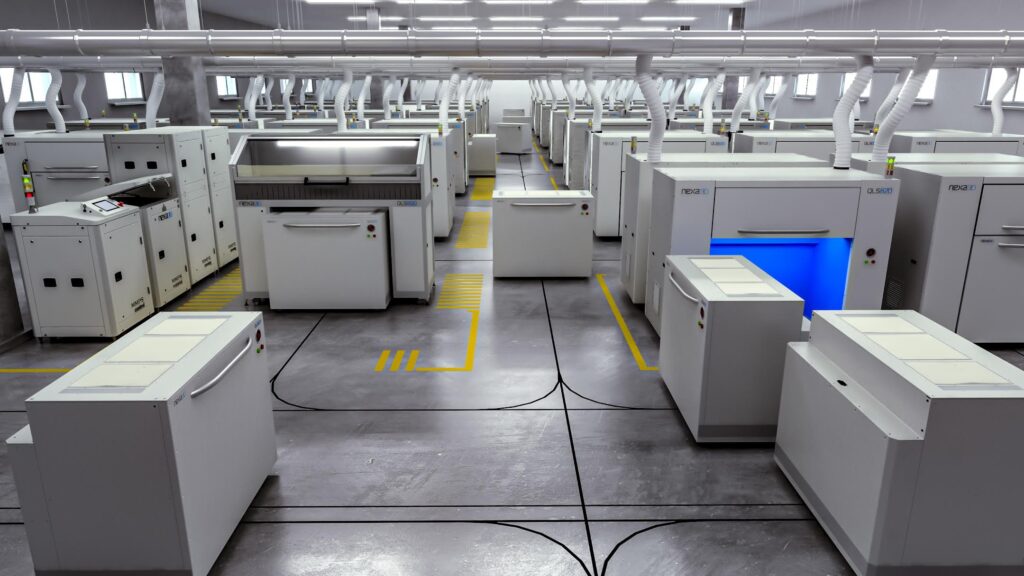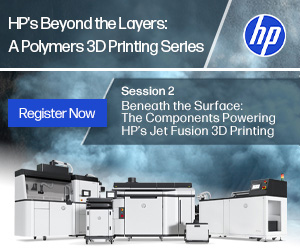It’s no secret that the business environment in the last few years has made mergers and acquisitions (M&As) tricky, a theme that has been rather visibly on display in the additive manufacturing (AM) sector throughout 2023. On the other hand, M&A activity has by no means come to a halt, and the latest evidence of this is Nexa3D’s acquisition of Essentium, announced today ahead of Formnext 2023 (November 7-10 in Frankfurt, Germany).

Based in Ventura, California, Nexa3D specializes in high-throughput stereolithography (SLA) and polymer powder bed fusion (PBF) platforms, making Essentium, with its signature High Speed Extrusion (HSE) technology, an ideal addition to the Nexa3D portfolio. The CEO of Nexa3D, Avi Reichental, and the CEO of Essentium, Blake Teipel, told me that the synergy between the two brands made the deal too compelling to ignore:
As Teipel straightforwardly summed up, “We get along. Our two companies have the same mindset. I’ve talked to leadership at other businesses and I’ve looked at other opportunities to join other teams, and Nexa really stood out. Their revenue is growing 2X year-over-year, and that’s because they’ve got this great commercial engine. Avi and I get along, but also, all the stuff that he has, and that he’s already built, would take me a long time and a lot of money to build myself. When the conversation gets to the point where you have to ask “why shouldn’t we join the businesses?” I think that’s where you need to get in order to have the makings of a successful merger.”

Reichental followed up on that by pointing out that the rationale for a merger should be based on compelling reasons to do so, rather than on fear of what could happen in lieu of a deal:
“Combining businesses is not a substitute for organic growth. It’s not a substitute for aging product lines,” Reichental said. “But it can be a force multiplier when it allows you to scale with a highly complementary portfolio. I think what made this deal successful for us is we had all the incentives in the world to do it, and we didn’t have any reason not to do it. Starting with the fact that fundamentally, these are complimentary businesses, and we can emerge out of this with one of the strongest IP portfolios in the industry, that is new, and fresh, and viable. And on top of all the business reasons, we just enjoy hanging out together, which is a bonus: the chemistry is right not just for the business, but just as importantly, on a personal level.”
Essentium is no stranger to the financial rockiness unleashed by the combination of the highest interest rates in decades and the onset of a bear market. In February 2022, right as US equities markets were starting their downward shift, Atlantic Coastal Acquisition Corp. backed out of a SPAC deal with Essentium that would have taken the company public. As a result, Essentium lost out on another deal that was in the works: the acquisition of 3D printing startup Collider.
In retrospect, given the track record of SPACs in the last couple of years especially, these developments look to have been a blessing in disguise. Instead of having to focus on a transition to being a publicly-traded company while simultaneously navigating the complications of bringing a new entity into its fold, Essentium has harnessed its focus and honed in on landing deals based on high-value applications like transportation and IoT. Essentium has also bolstered its credentials as a partner to the US military, participating in the US Navy’s 2022 REPTX exercises and providing its HSE platform to the Maine Air National Guard.

Reichental specifically highlighted Essentium’s government contracting experience as one of the key factors that made the company an attractive buy:
“As we started surveying the field, Essentium really stood out not only because they had a very complimentary portfolio of products, but they also have a very complimentary go-to market strategy,” the Nexa3D CEO said. “They enjoy the bulk of their success today in DoD-related and government-related applications. And that’s an area that Nexa today doesn’t have much exposure to. On the other hand, for Nexa, we enjoy a great deal of industrial access to the market through our network of resellers that is now about 130 strong. So we also have the complementary nature of two different go-to-market motions that could be leveraged now to the benefit of the combined entity.”
Thus, when considering the two companies as a pair, each exhibits a unique combination of overlapping selling points with an ability to fill in gaps that the other company is lacking: “With Essentium, there is another very interesting complementary aspect, which is that Essentium is at its core a material science company, while Nexa at its core is a printer company — hardware, software, and applications.”

That synergistic combination is perhaps most strikingly apparent in the fact that Essentium specializes in extrusion, the missing link in Nexa’s portfolio. From the reverse perspective, all of the processes that are Nexa3D competencies allow Essentium to diversify the ways in which it can serve its impressive customer base:
“We’re delighted to bring Nexa’s products into the same conversations where, for instance, government users need to produce different types of parts that are suitable for photoresin or powder bed fusion,” said Teipel. “Now, our government team has access to that whole Nexa3D portfolio, and we’re able to serve the same clients for the different needs that they have.”
As they’re closing out this year on such a strong note, it is unsurprising that Reichental and Teipel are both optimistic about the AM sector’s potential in 2024:
“Even in this climate, notwithstanding some injured companies, the sector as a whole continues to grow and continues to perform relatively well considering the perfect storm of both economic and geopolitical uncertainty,” Reichental said. “I have a lot of hope for this industry, and I’ve said it many times before, even in this difficult moment, there’s never been a better time to be in it — except maybe next year. Having said that, to do what Blake and I have done across time, you’d have to be an optimist, because if you’re not, you probably wouldn’t get into this business to begin with.” Echoing that, Teipel concluded, “For us, we’re excited about 2024 because we believe this combination makes a ton of sense. Our combination is going to be done, we’re going to be hitting the ground running, and hopefully a lot of that other noise in the data for the sector as a whole will just be in the past.”
Subscribe to Our Email Newsletter
Stay up-to-date on all the latest news from the 3D printing industry and receive information and offers from third party vendors.
Print Services
Upload your 3D Models and get them printed quickly and efficiently.
You May Also Like
3D Printing News Briefs, June 4, 2025: Full-Color Slicer, Denture Implants, & More
In today’s 3D Printing News Briefs, we’ll start with some software and post-processing news, and then move on to a case report in which digital dentistry was successfully used. Read...
3D Printing News Briefs, May 31, 2025: Project Call, Consortium, Certification, & More
We’re starting with the latest America Makes Project Call in today’s 3D Printing News Briefs, and a consortium to promote the adoption of additive manufacturing has been founded in Spain....
3D Printed Microgels from Terasaki Institute Could Help Heal Tissue
In a major step forward for tissue engineering, scientists at the Terasaki Institute for Biomedical Innovation (TIBI) in Los Angeles have developed a light-based 3D printing technique that guides cells...
Insight Surgery Receives $2.5 Million Investment & FDA Clearance for 3D Printed Guides
UK-based Insight Surgery has received a $2.5 million investment, with the round led by medtech investor Nodenza Venture Partners. Insight has a workflow solution for end-to-end design and printing of...































